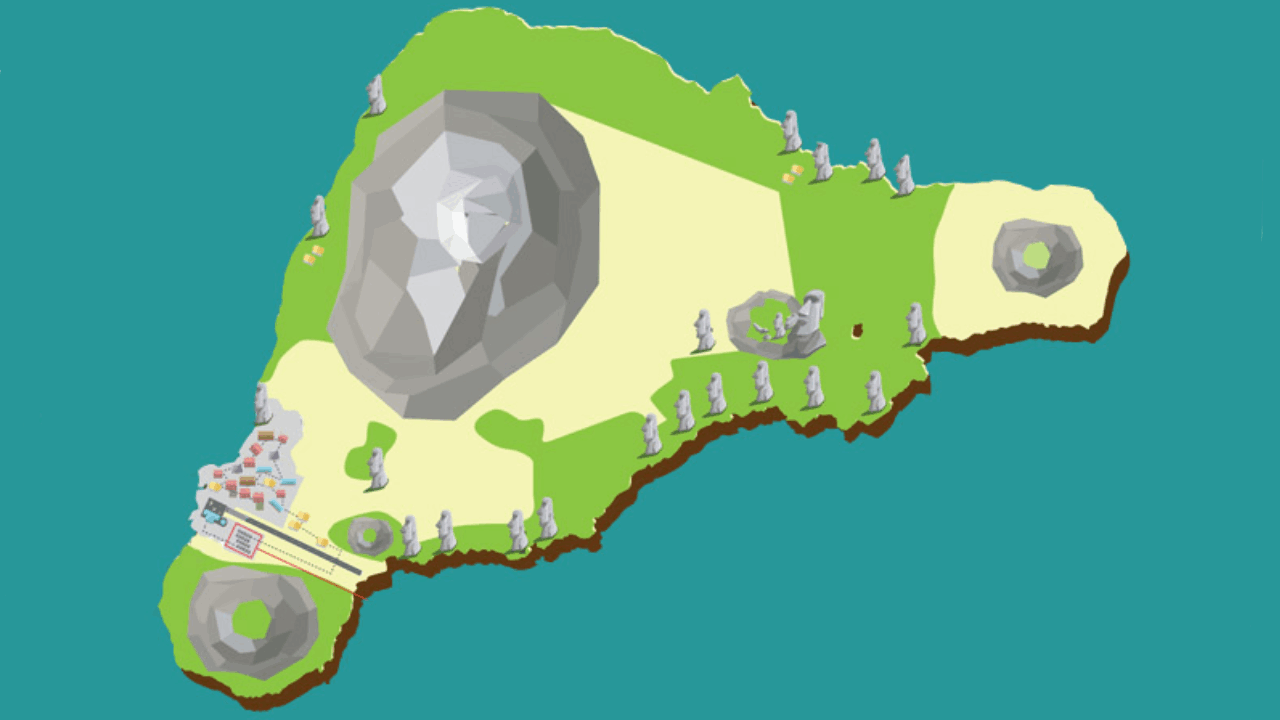No one knows for sure the origin of the civilization of Easter Island. This 160 km2 triangle of earth emerging from the middle of nowhere in the Pacific Ocean, between Chile and the Polynesian islands, continues to be a mystery. Documents exist that appear to explain its origin, but we cannot read them yet, because the writing has still to be deciphered. Everything is legend on Rapa Nui, borne from the testimonies of the generations that founded history and myth.
Oral history passed down tells us how the first settlers arrived on the island. Explorers from Hiva, a Pacific continent about to disappear, had adventured forth in search of a place they could move to. It was no coincidence they reached these shores. The sage, Hau Maka, had dreamed that this far-off island would be their next destination and to find it they had to search for thousands of leagues “in the direction of the rising sun”.
Whether this story has a basis in fact or not is the subject of debate by researchers. But what is for sure, is that today the inhabitants of Easter Island have returned, as their ancestors did, to following the Sun to seek their future survival and that of their ecosystem. Until now, all the electricity consumed on Rapa Nui has been generated using diesel oil. But now the island has its first solar energy plant, donated by ACCIONA, with the aim of making it a more sustainable and cleaner place. The Sun is once again marking the direction the Easter islanders should take, to fulfil their wish to bequeath the generations to come a better place to live.
…Ancient Rapa Nui, that calls without speaking, forgive us our intrusive chatter: we have come from all parts to spit in your lava, we arrive brim with our conflicts, differences, blood, laments and digestions, fresh from war and peaches…”
Pablo Neruda
Rapa Nui was a fertile resource-rich island and with a society which, in view of its megaliths and enigmatic moais, must have been highly advanced. These giant stones, whose name means “the living face of the ancestors”, were sculpted to host the soul of their predecessors and protect them with their spiritual power or manna. But, since the arrival of those first settlers, its civilization has been on the edge of environmental collapse at several junctures: the indiscriminate felling of trees in the past, illegal fishing, and the disappearance of birds due to the plundering of their eggs for food, were partly responsible.
Added to these problems came the growing overpopulation of the island, tourism, littering and pollution, which have threatened its environment in recent years. Around 100,000 tourists visit the isle every year, a staggering number when you consider the last census of people living there was just 7,750, of which over 3,500 belong to the indigenous Rap Nui people. These are, of course, important sources of income, but they also form an environmental challenge to which the answer lies in sustainable development and clean energies.
The airport lies on the south-east of the island, a runway on which passengers arrive on little more than one regular flight a day from Santiago de Chile or Papeete, capital of the French Polynesian island of Tahiti, aside from the odd chartered flight or private plane that lands. The photovoltaic plant is located very close to this enclave connecting the island with the outside world and feeds the island’s electricity grid. It is the first renewable energy facility to supply electricity to the island.
The installation of the photovoltaic system - designed, built and donated by ACCIONA – required the resolution of unimaginable difficulties, compared to a similar project at a mainland location. Rapa Nui has no large port, due to its rugged volcanic coast. Cargo ships have to anchor hundreds of meters from the island and use barges to ferry goods to the coast. Sometimes rough seas complicate the passage, so the equipment and materials ACCIONA needed to build the plant not only had to be transported in ships nearly 4,000 kilometers across the ocean, but, once they arrived at the island, wait weeks at times until the sea allowed them to be unloaded. There is no place for rushing on Easter Island; nature is sovereign.
But, after several months of work by ACCIONA teams the Tama Te Ra’a (“the Sun’s first rays”) facility was being operated at full power by the electric utility SASIPA, the CORFO subsidiary which supplies electricity and drinking water on Easter Island.
The plant consists of: 400 polycrystalline silicon panels, mounted on 10 fixed structures, which together achieve a peak output of 128 kWp (100 kW nominal); an inverter, which transforms the electricity generated into a continuous alternating current; a transformer that raises the output voltage from 0.42 to 13.2 kilovolts, and; a 100-meter-long transmission line to transport the electricity to the Mataveri substation for injecting into the island’s grid.
This equipment is designed to serve the island’s needs well over time. The plant will generate an average 200 MWh per year, avoiding the direct emission of some 135 tonnes of CO2 annually; and that’s without calculating the emissions produced in the transportation of diesel oil from the continent for the previous fossil combustion. Tama Te Ra’a and its clean electricity now produce the equivalent of 8% of the island’s electricity demand previously generated by burning diesel.
This is just the beginning of a long journey toward sustainability on Rapa Nui - and of the mainstreaming of renewable energies on the island. Tama Te Ra’a is ACCIONA’s contribution to this quest for a better place to live. Guided, as Hau Maka was, centuries before, by the rays of the Sun.
